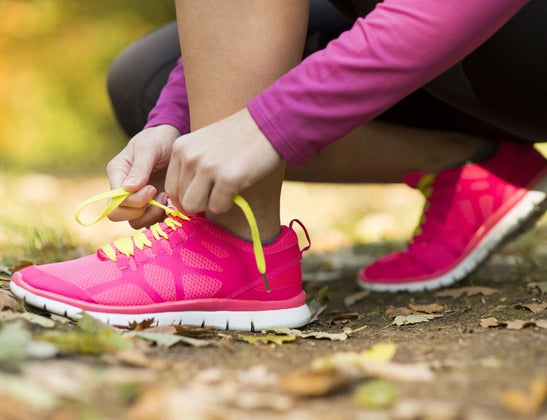New perk! Get after it with local recommendations just for you. Discover nearby events, routes out your door, and hidden gems when you sign up for the Local Running Drop.

Between pronation, midsoles, gait analysis, and heel to toe drops—it’s no wonder shopping for new running shoes can sometimes feel overwhelming. Never fear—Women’s Running is here! Arm yourself with the proper lingo so that next time you head out to pick up a new pair of kicks you can talk the talk and walk the walk (or run the run!).
Shoe Talk, Decoded
Neutral Shoe—A supportive and cushioned shoe designed to support a gait that evenly distributes weight throughout the foot with no overpronation or supination.
Stability Shoe—A cushioned shoe with added motion control support to compensate for a gait that rolls weight unevenly to the outside or inside of the foot.
Minimalist Shoe—A basic shoe that mimics barefoot running with some protection.
Gait—A pattern of movement. A woman’s gait defines how she distributes weight on her foot from the time it touches the ground to the time it leaves to take another step.
Gait Analysis—An evaluation performed by a trained professional to determine what type of gait a runner possesses. Typically offered at specialty running stores.
Overpronation—Excessive rotation of the foot toward the middle of the body during a step.
Supination—Outward rotation that causes a rolling motion to the outside edge of the foot during a step. Also referred to as underpronation.
Forefoot—The front area of the foot.
Insole—The inside part of the shoe that touches the bottom of the foot.
Outsole—The outermost layer of the sole of a shoe.
Midsole—A layer of material between the inner and outer soles of a shoe, for absorbing shock.
Upper—The part of the shoe that covers the toes, sides of the foot and the back of the heel. The upper is attached to the outsole to offer protection to the feet.
Heel To Toe Drop—The difference between the heel height and the forefoot height of a shoe. A heel to toe drop of zero is equal to being barefoot. A lower heel to toe drop numbers means the shoe supports forefoot or mid foot striking during running.
Racers vs. Trainers—Some runners choose to train in a heavier, more cushioned shoe and race in a lighter weight shoe. Trainers are typically built to endure many miles while supporting the feet. Racers support the feet, but are considered lightweight to encourage a faster turnover in the stride and ultimately increase running pace.